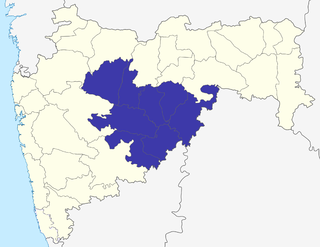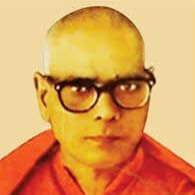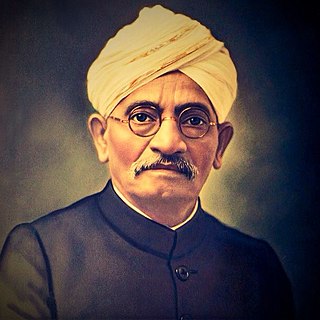
Hyderabad State was a princely state located in the south-central Deccan region of India with its capital at the city of Hyderabad. It is now divided into the present-day state of Telangana, the Kalyana-Karnataka region of Karnataka, and the Marathwada region of Maharashtra in India.

Marathwada is a proposed state and geographical region of the Indian state of Maharashtra. It was formed during the Nizam's rule and was part of the then Hyderabad State. The region coincides with the Aurangabad division of Maharashtra. It borders the states of Karnataka and Telangana, and it lies to the west of the Vidarbha and east of Uttar Maharashtra regions of Maharashtra. The largest city of Marathwada is Aurangabad. Its people speak Marathi and Deccani Urdu.

The princely state of Hyderabad was annexed by India in September 1948 through a military operation code named Operation Polo, which was dubbed a "police action".

Nizam of Hyderabad was the title of the ruler of Hyderabad State. Nizam is a shortened form of Niẓām ul-Mulk, which means Administrator of the Realm, and was the title bestowed upon Asaf Jah I when he was appointed Viceroy of the Deccan by the Mughal Emperor Farrukhsiyar. In addition to being the Mughal Viceroy (Naib) of the Deccan, Asaf Jah I was also the premier courtier of the Mughal Empire until 1724, when he established the independent monarchy of Hyderabad and adopted the title "Nizam of Hyderabad".

Kasim Razvi was a politician in the princely state of Hyderabad. He was the president of the Majlis-e-Ittehadul Muslimeen party from December 1946 until the state's accession to India in 1948. He was also the founder of the Razakar militia in the state. He held the levers of power with the Nizam of Hyderabad, blocking the possibilities of his accommodation with the Dominion of India.

The Razakars were the paramilitary volunteer force of the nationalist party in the Hyderabad State under the British Raj. Formed in 1938 by the Majlis-e-Ittehadul Muslimeen leader Bahadur Yar Jung, they expanded considerably during the leadership of Qasim Razvi around the time of Indian independence. They were deployed in the cause of maintaining Muslim rule in Hyderabad and resisting integration into India. Described as "enthusiastic" and "disciplined", they attacked and committed atrocities against Hindus and Muslims who were disloyal to the regime of the Hyderabad State and fought against communists who were launching a revolution against the Hyderabad State and the state's feudal lords like doras and deskhmukhs.

Makhdoom Mohiuddin, or Abu Sayeed Mohammad Makhdoom Mohiuddin Khudri, was an Urdu poet and Marxist political activist of India who founded the Progressive Writers Union in Hyderabad and was active with the Comrades Association and the Communist Party of India, and at the forefront of the 1946–1947 Telangana Rebellion against the Nizam of the erstwhile Hyderabad state.
The Telangana Rebellion, natively known as Telangana Sayudha Poratam, was a communist-led insurrection of peasants against the princely state of Hyderabad in the region of Telangana that escalated out of agitations in 1944–46.
Mallu Venkata Narasimha Reddy was an Indian revolutionary leader and one of the prominent heroes of the Telangana Rebellion. Remained underground for nine long years, he had organised the armed squads in battling the Nizam's army and the razakars. He steadfastly upheld the revolutionary tenets of Marxism–Leninism and played an important role when both the revisionist and the Left adventurist divisions had deeply divided the communist movement in Andhra Pradesh.
Sulaiman Areeb was an Indian poet from Aurangabad.

Swami Ramanand Tirtha was an Indian politician, freedom fighter, educator and social activist who led the Hyderabad liberation struggle during the reign of Osman Ali Khan, the last Nizam of Hyderabad State. Swami Ramanand Tirtha was the principal leader of the Hyderabad State Congress. Before taking Sanyasa, his family name was Vyenkatesh Bhagvanrao Khedgikar.

Keshav Rao Koratkar, was a pioneer of political, social, and educational reforms in Hyderabad State, India. Initially working on behalf of the Marathi people, he became involved in the Indian independence movement.

Lieutenant Colonel Saeed ul-Mulk Nawab Sir Muhammad Ahmad Said Khan, Nawab of Chhatari also generally referred to as Nawab of Chhatari was Governor of the United Provinces, Chief Minister of United Provinces, President of the Executive Council of the Nizam of Hyderabad and Chief Scout of India.

Andhra Mahasabha was a people's organisation in the erstwhile Hyderabad state of India. The organization spearheaded people's awareness and people's movements among the Telugu-speaking populace of the state and eventually joined hands with the Communist Party of India to launch the Telangana rebellion.
The Hyderabad State Congress was a political party in the princely state of Hyderabad that sought civil rights, representative democracy and the union of Hyderabad with the Republic of India. It opposed the autocratic rule of the Nizam of Hyderabad and the militancy of the Razakars. HSC was formed in 1938.
Nawab Moin Nawaz Jung was the Minister for Finance and External Affairs of the Hyderabad State, under the Nizam Osman Ali Khan's reign.

The Hyderabad State Forces were the armed forces of the princely state of Hyderabad. People from both India and abroad were recruited into the Forces. Among these groups were Arab nationals like Chaush and African nationals like Siddis who now stay in Barkas and A. C. Guards areas of Hyderabad respectively. The Hyderabad cavalry was chiefly composed of Muslim castes such as Mughals, Pathans, Syeds, Sheikhs and Balochs. They were principally recruited from the Deccan, but Delhi, Lucknow, Shahjahanpur, Sindh and Balochistan also supplied recruits to bolster ranks. These non-indigenous soldiers were known as the "Rohollas". The Hindus made a very small portion of the cavalry. The Nizam of Hyderabad also had about 1200 Sikh guards. Other battalions within the army were referred to with the suffix "-walas". Some troops were also supplied by the Europeans for the security of the Nizam.

The history of Telangana, located on the high Deccan Plateau, includes its being ruled by the Satavahana Dynasty, the Kakatiya Dynasty (1083–1323), the Musunuri Nayaks (1326–1356), the Delhi Sultanate, the Bahmani Sultanate (1347–1512), Golconda Sultanate (1512–1687) and Asaf Jahi dynasty (1724-1950).
A standstill agreement was an agreement signed between the newly independent dominions of India and Pakistan and the princely states of the British Indian Empire prior to their integration in the new dominions. The form of the agreement was bilateral between a dominion and a princely state. It provided that all the administrative arrangements, existing between the British Crown and the state would continue unaltered between the signatory dominion and the princely state, until new arrangements were made.

Raj Bahadur Gour was a freedom fighter and trade unionist. He was active with the Comrades Association and the Communist Party of India, and at the forefront of the 1946–1947 Telangana Rebellion against the Nizam of the erstwhile Hyderabad state. He was founder general secretary of the AITUC affiliated All Hyderabad Trade Union Council of which Makhdoom Mohiuddin was the president. He was elected to the Rajya Sabha in 1952 while in jail.














